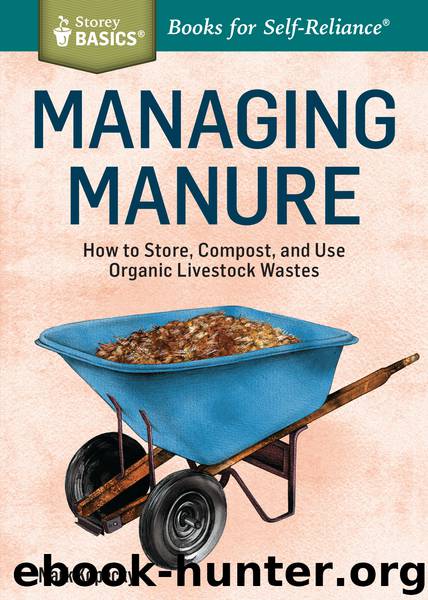Managing Manure by Mark Kopecky

Author:Mark Kopecky
Language: eng
Format: epub
Tags: farm;farming;manure;compost;horse;horse manure;profitable;nutrient;storing;composting;spreading;certified-organic;fertilizer;organic farms;livestock;various species;valuable;livestock waste;store
Publisher: Storey Publishing, LLC
Published: 2015-01-12T20:15:45+00:00
Interpreting Your Test Results
For both soil and manure tests, as well as fertilizer recommendations, it’s important to understand how the results are expressed.
Nitrogen (N) is usually expressed in its elemental equivalent when it comes to fertilizer materials; in other words, how much pure nitrogen is in the sample if it could be separated out from the rest of the material.
Phosphorus (P) in fertilizer is usually represented by its oxide equivalent (an old convention dating back to earlier days of chemistry). The chemical formula for its oxide is P2O5, usually referred to as phosphate.
Potassium (K) in fertilizer is likewise represented by its oxide equivalent, K2O, usually referred to as potash.
Soil tests may or may not show nitrogen levels, because nitrogen is difficult to measure in soils and can be present in many different forms. In fact, most of the time when we have ordinary soil samples analyzed for nitrogen, the results aren’t very useful. This is because nitrogen can be present in so many forms in soils, and labs often measure only nitrate. There are valid ways to measure soil nitrate to provide useful information, but you must follow a very specific protocol to get meaningful results. Newer tests such as the Solvita biological respiration test and the Haney test give better results, and these can be performed on ordinary soil samples.
Soil tests usually give the analysis of phosphorus and potassium listed in their elemental form, because agronomists are used to interpreting soil test results according to numbers expressed that way. But if they include recommendations for applying phosphorus and potassium fertilizer, those are usually given in the oxide form.
To further complicate the matter, the elemental concentrations in soil samples can be given as either parts per million or pounds per acre! Don’t worry, though — the conversion between these is pretty straightforward: an acre of completely dry average soil to a depth of about 6 inches is assumed to weigh 2 million pounds, so to convert parts per million to pounds per acre, just multiply by two. To convert pounds per acre to parts per million, divide by two. Easy!
When fertilizer is sold, the analysis is always listed with a set of three numbers according to this formula: Percent nitrogen as its elemental basis (N)-percent phosphate (P2O5)-percent potash (K2O). For example, a fertilizer with an analysis of 9-23-30 would translate as 9 percent elemental nitrogen, 23 percent phosphate (P2O5), and 30 percent potash (K2O).
With manure, the nutrient value is usually expressed as pounds of nutrients per ton of manure (for solid manure) or per 1,000 gallons (for liquid). Although manure contains all the nutrients necessary for plants to grow, labs don’t usually test it for anything beyond nitrogen, phosphorus, and potassium (although they occasionally test for sulfur). Manure tests are designed to measure how much fertilizer value the manure has with respect to these major nutrients. Manure test results may report the content of the major nutrients in their elemental form, as their oxide form (for phosphorus and potassium), or both.
Download
This site does not store any files on its server. We only index and link to content provided by other sites. Please contact the content providers to delete copyright contents if any and email us, we'll remove relevant links or contents immediately.
| Container Gardening | Hydroponics |
| Organic | Propagation & Cultivation |
| Topiary | Urban |
| Water Gardens & Ponds |
Turbulence by E. J. Noyes(7977)
The Thirst by Nesbo Jo(6877)
Gerald's Game by Stephen King(4609)
Be in a Treehouse by Pete Nelson(3996)
Marijuana Grower's Handbook by Ed Rosenthal(3643)
The Sprouting Book by Ann Wigmore(3561)
The Red Files by Lee Winter(3391)
The Remains of the Day by Kazuo Ishiguro(3347)
Sharp Objects: A Novel by Gillian Flynn(2984)
Christian (The Protectors Book 1) by L. Ann Marie(2669)
Organic Mushroom Farming and Mycoremediation by Tradd Cotter(2661)
The Culinary Herbal by Susan Belsinger(2453)
Stone Building by Kevin Gardner(2372)
The Starter Garden Handbook by Alice Mary Alvrez(2307)
Lilac Girls by Martha Hall Kelly(2272)
The Unlikely Pilgrimage of Harold Fry by Rachel Joyce(2242)
The Lean Farm Guide to Growing Vegetables: More In-Depth Lean Techniques for Efficient Organic Production by Ben Hartman(2107)
Urban Farming by Thomas Fox(2083)
Backyard Woodland by Josh VanBrakle(1910)
